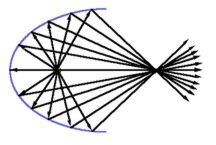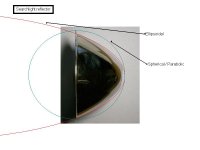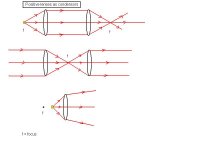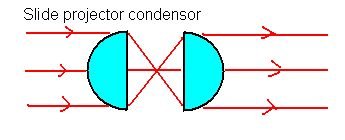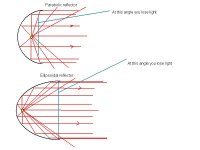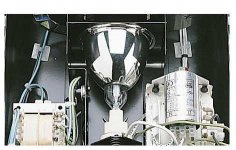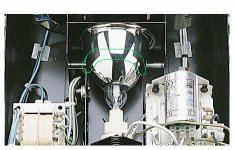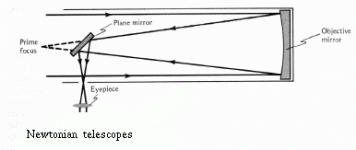The ellipticalreflector design is used in all modern slideprojectors with a lamp of the type ELC A1/259 with built in reflector. And the other designs use the normal ohp-design.
There is not 1 eliptical reflector in your design, eliptical reflectors have 2 focal points, i only see a wide angle spot reflector, a spherical reflector and a parabolic reflector in your drawings.
Eliptical reflector:
Attachments
Here is a little somthing for hezz to help him along his way with his lens design.
http://wwwhip.obspm.fr/gaia/rvs/workshop6/FChemla_optics.pdf
http://wwwhip.obspm.fr/gaia/rvs/workshop6/FChemla_optics.pdf
As you can see in the picture the reflector I use and show in my slideprojector designs is a ellipsoidal reflector and the light beam out of it is parallel and this type of reflector is very common in searchlight. I really don´t understand why you write things that is not true.There is not 1 eliptical reflector in your design, eliptical reflectors have 2 focal points, i only see a wide angle spot reflector, a spherical reflector and a parabolic reflector in your drawings.
Attachments
You have also wrong in this statement, positive lenses work exactly as I have drawn.There is no way u will get rays out of a positive power lens in the way you show it, paralelle or non paralelle light, the light will go to the focal point of the lens.
Attachments
Mathias for your post above they are double convex lens, they are not plano convex in what im talking about and they are used as condenser's, if u want to argue on the truth, then dont argue with me, my information is from optical engineers who have phd's in all areas of optics, and this information come from the net acociated to their knewlege, for the record eliptical reflectors dont put out paralelle light and all have 2 focal points as i have stated above with the atached image, that image isnt draw by me btw. So now its upto you to find the truth and do the study for yourself, ive done the study ive contacted who i have had to contact and i know the truth, no guesses but answers from optical engineers who have studdied over this complete matter.
Trev
Trev
Mathias, read this page, look at light, its an eliptical reflector and with the coresponding 2 focals, in the diagram that shows the 3lcd's its clear how it works, it is also clear that your angles are incorect from the condenser to the frensel, so maybe an apology may be in order.
http://www.extremetech.com/print_article/0,3998,a=15893,00.asp
Trev
http://www.extremetech.com/print_article/0,3998,a=15893,00.asp
Trev
I have drawn normal positive lensen because it´s more easy to draw. There are not any diffrence between double convex lenses and plano convex more then plano convex have better optical quality.
Eliptical reflectors actully give parallel light, if you move the lamp backward in the reflector, this is how all searchlight works, if you don´t beleave me, try it yourself !
If you got your information from a optical engineer I think you have misunderstand him a lot, I have myself read many books from the University about optics and I am a enginner myself, and I think it´s unfortunately that you say people have wrong when you don´t really know that.
Eliptical reflectors actully give parallel light, if you move the lamp backward in the reflector, this is how all searchlight works, if you don´t beleave me, try it yourself !
If you got your information from a optical engineer I think you have misunderstand him a lot, I have myself read many books from the University about optics and I am a enginner myself, and I think it´s unfortunately that you say people have wrong when you don´t really know that.
Attachments
Mathias, i realy dont know what your problem is, i see you cant admit to being wrong, my proof is in the pages that ive posted and is very clear, so realy if you take a look at the odds, then your the one who realy needs to read and to realise where you have gone wrong. Ive tried to help you mathias to show you where you are wrong but you cant acept the truth, it is now not my problem and i will not discuss this matter further with you.
Trev
Trev
I don´t understand why you have so hard to understand. That page you linked to prove that you get parallel light out of a eliptical reflectors. When they move the lamp backward in the second picture they get the focus on a longer distance from the reflector. What do you think happen when they move it more backward ? Maybe parallel light ?
And I haven´t any problem more than I want people to know the truth !
But thanks for the link, it helps me with my pro-projector.
And I haven´t any problem more than I want people to know the truth !
But thanks for the link, it helps me with my pro-projector.
Guys,
Correct me if I am wrong,
But my understanding is that parabolic reflectors give off the best parallel light if the light source is small and located near the bottom of the reflector. But you would have to contain the front light cone either by filament design or by blocking it otherwise you have two main light paths. This is the problem with most illustrated examples is that they are only emphisizing one aspect of the light projection.
Elliptical reflectors can be misleading because there are many shapes of elliptical. If you place a light source at one of the focal points of an elliptical reflector the reflected light will be directed at the second focal point. However if you place a small light source which is small in relation to the reflector near the bottom of an elliptical reflector it will be somewhat more parallel but not as much as a parabolic. A parabolic curve is defined by a specific mathmatic equation that shows common trends in statistical sampling. The closer the shape of an elliptical reflector is to a parabolic the more like the parabolic it will act if you set the light source up the same way. However it will not create parallel light as well as a perfectly made parabolic.
Now, even with a parabolic you cannot get perfectly parallel light because in the real world you cannot get a perfect point source of light with the front light cone removed. One has to wonder though if you couldn't use a very small lens close to the light source to collumate the front light cone. And having it just the right diameter as to catch all of the light that missed the outer edges of the reflector. Assuming of course you want parallel light. This does mean that the condenser FL and diameter needs to be designed differently for complimenting the parallel light coming from the reflector.
If you are working with the front light cone and treating the incoming light as a point source then dealing with the back and side reflected light becomes the issue. This is where the circular reflector comes in but one has to wonder if it is perfectly aligned if the light will be dispursed by hitting the filament again. This design seems to be the easiest to execute but one need a spherical light element for it to work at it's best.
Since most light element are a piece of wire or a cylindrical piece of ceramic it would seem that in most cases the element is long and not a point. It almost seems like it would be better to lay the element horizontally in relation to the LCD and have a long filament as wide as the LCD and have a half cylindrical reflector and a cylindrical condenser lens because the light comming off from the ends of the light element is less and is further away from the point source. Maybe it should be disgarded.
Hezz
Correct me if I am wrong,
But my understanding is that parabolic reflectors give off the best parallel light if the light source is small and located near the bottom of the reflector. But you would have to contain the front light cone either by filament design or by blocking it otherwise you have two main light paths. This is the problem with most illustrated examples is that they are only emphisizing one aspect of the light projection.
Elliptical reflectors can be misleading because there are many shapes of elliptical. If you place a light source at one of the focal points of an elliptical reflector the reflected light will be directed at the second focal point. However if you place a small light source which is small in relation to the reflector near the bottom of an elliptical reflector it will be somewhat more parallel but not as much as a parabolic. A parabolic curve is defined by a specific mathmatic equation that shows common trends in statistical sampling. The closer the shape of an elliptical reflector is to a parabolic the more like the parabolic it will act if you set the light source up the same way. However it will not create parallel light as well as a perfectly made parabolic.
Now, even with a parabolic you cannot get perfectly parallel light because in the real world you cannot get a perfect point source of light with the front light cone removed. One has to wonder though if you couldn't use a very small lens close to the light source to collumate the front light cone. And having it just the right diameter as to catch all of the light that missed the outer edges of the reflector. Assuming of course you want parallel light. This does mean that the condenser FL and diameter needs to be designed differently for complimenting the parallel light coming from the reflector.
If you are working with the front light cone and treating the incoming light as a point source then dealing with the back and side reflected light becomes the issue. This is where the circular reflector comes in but one has to wonder if it is perfectly aligned if the light will be dispursed by hitting the filament again. This design seems to be the easiest to execute but one need a spherical light element for it to work at it's best.
Since most light element are a piece of wire or a cylindrical piece of ceramic it would seem that in most cases the element is long and not a point. It almost seems like it would be better to lay the element horizontally in relation to the LCD and have a long filament as wide as the LCD and have a half cylindrical reflector and a cylindrical condenser lens because the light comming off from the ends of the light element is less and is further away from the point source. Maybe it should be disgarded.
Hezz
Hezz i agree with you 100% and what you say is corect, all reflectors are made for a specific purpose, elipticals are made to make a second focal point to guide the most amount of light through the optics, also they cover more of the frontal light being radiated from the bulb to this point and i may add its also why its the most eficient reflector made to date. On your last statement with the arc being horizontal there are eliptical reflectors that alow the bulb to be placed at such angles for the bigger arced bulbs, its true what you say though no way can u get the perfect focal points with a arc thats big, im talking even 4mm is big, 1mm is ideal.
Trev
Trev
As Hezz write there are many shapes of elliptical reflectors. But I think you have missed the most important why to use a elliptical reflector. I hope my drawing clear this up. The biggest reason why they use elliptical reflectors in most searchlight, is that you can use more light from the front light cone, that will get lost in a parabolic reflector. The elliptical reflector is the most effective reflector you can use.
Attachments
This is a picture from a professional light disco equipment, The Alchemist posted this before, this is a typical elliptical reflector. If you don´t beleave me that this type of reflectors is very common, go to the nearest hobby shop and look on some different searchlight-lamps, most of them will have a elliptical reflector.
Attachments
mathias, i sujest you do abit more reading on this matter. The link that i posted earlier even states the eliptical reflector has 2 focal points and its the way they are used. The second focal guides the light through the optics in an non paralelle manner, also remember light going through a lens as hezz stated gets reflected back to its source, the ultimate in most cases is 45deg of angle at the lens surface. All of your answers are in here, it is now upto you to see where you are wrong.
Trev
Trev
As for the picture above, how do you know its a eliptical reflector? it doesnt say it is does it? it could be a parabolic with a light guide wich in turn in my eyes is what it looks like to me, or an eliptical with a light guide. Its strange how the radious from the back reflector has a bend to join to the front top half, so i would asume the top half is a light guide. No reflector will have any bend marks in it like the one above if it was all a eliptical reflector, so it has to be half a light guide. If this is a eliptical reflector it would have a long focal point, if its a parabolic well the obvious.
Trev
Trev
I must agree with ace. An eliptical reflector has two focal points, that the nice thing of those refelectors because you don't need a condensor lens.
A parabolic reflector is not an eliptical one.
Look at this article, very nice pic's.
Ps. Ace did you looked at the topic on fresnell condesor distance. Do you understant the equations in my post?
A parabolic reflector is not an eliptical one.
Look at this article, very nice pic's.
Ps. Ace did you looked at the topic on fresnell condesor distance. Do you understant the equations in my post?
I know that eliptical reflector has two focal points, but if you place the lightsource BEHIND the first focus, the light beams will NOT go to the second focus point, they will be more like a parallel beam, maybe you get a second focus point 200 meters away.
And the above picture is eliptical, is´t not bend in anyway it´s the reflection that make it look like that.
I haven´t seen any picture yet that say I have wrong, all picture show the lightsource in the focuspoint, but that is not what i use.
Why don´t anyone place the lightsource behind the focuspoint and then tell´s me what happens ?
Have anyone actully seen what type of reflector they use in a normal searchlight ?
And the above picture is eliptical, is´t not bend in anyway it´s the reflection that make it look like that.
I haven´t seen any picture yet that say I have wrong, all picture show the lightsource in the focuspoint, but that is not what i use.
Why don´t anyone place the lightsource behind the focuspoint and then tell´s me what happens ?
Have anyone actully seen what type of reflector they use in a normal searchlight ?
Have anyone actully seen what type of reflector they use in a normal searchlight ?
I have one right here, it also uses a lens to concentrate the beam.
I know that eliptical reflector has two focal points, but if you place the lightsource BEHIND the first focus, the light beams will NOT go to the second focus point, they will be more like a parallel beam, maybe you get a second focus point 200 meters away.
Yeah thats right and its not what its designed for or how its used.
And the above picture is eliptical, is´t not bend in anyway it´s the reflection that make it look like that.
Take another look, it has a form mark to change its shape, that is the light guide taking over from the reflector.
Attachments
Hi Guy's,
I've had a long time away from the forum, and this thread caught my eye.
If i might be so bold to say I agree with ACE, in that the best reflector to get parellel rays would be parobolic is shape.
This is the one of the most important factors in another hobby
of mine.... Astronomy.
The newtonian telescope uses 2 mirrors to reflect the from distant
start to a single point. this point is then magnifed with the use of an eyepiece to gain a image of the observed object.
The light from these start in our own galaxy may have taveled up to 100,000 light years to reach us. This point of light can then be deemed to be at optical infinaty. thus the light rays are parellel
So in our DIY projectors we are trying to get a parellel light from a point of light. It's a telescope in reverse, on a slightly smaller scale !!
I've had a long time away from the forum, and this thread caught my eye.
If i might be so bold to say I agree with ACE, in that the best reflector to get parellel rays would be parobolic is shape.
This is the one of the most important factors in another hobby
of mine.... Astronomy.
The newtonian telescope uses 2 mirrors to reflect the from distant
start to a single point. this point is then magnifed with the use of an eyepiece to gain a image of the observed object.
The light from these start in our own galaxy may have taveled up to 100,000 light years to reach us. This point of light can then be deemed to be at optical infinaty. thus the light rays are parellel
So in our DIY projectors we are trying to get a parellel light from a point of light. It's a telescope in reverse, on a slightly smaller scale !!
Attachments
- Status
- This old topic is closed. If you want to reopen this topic, contact a moderator using the "Report Post" button.
- Home
- General Interest
- Everything Else
- The Moving Image
- Optics
- DIY-Projector Plans and theory collection !!
